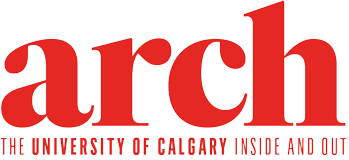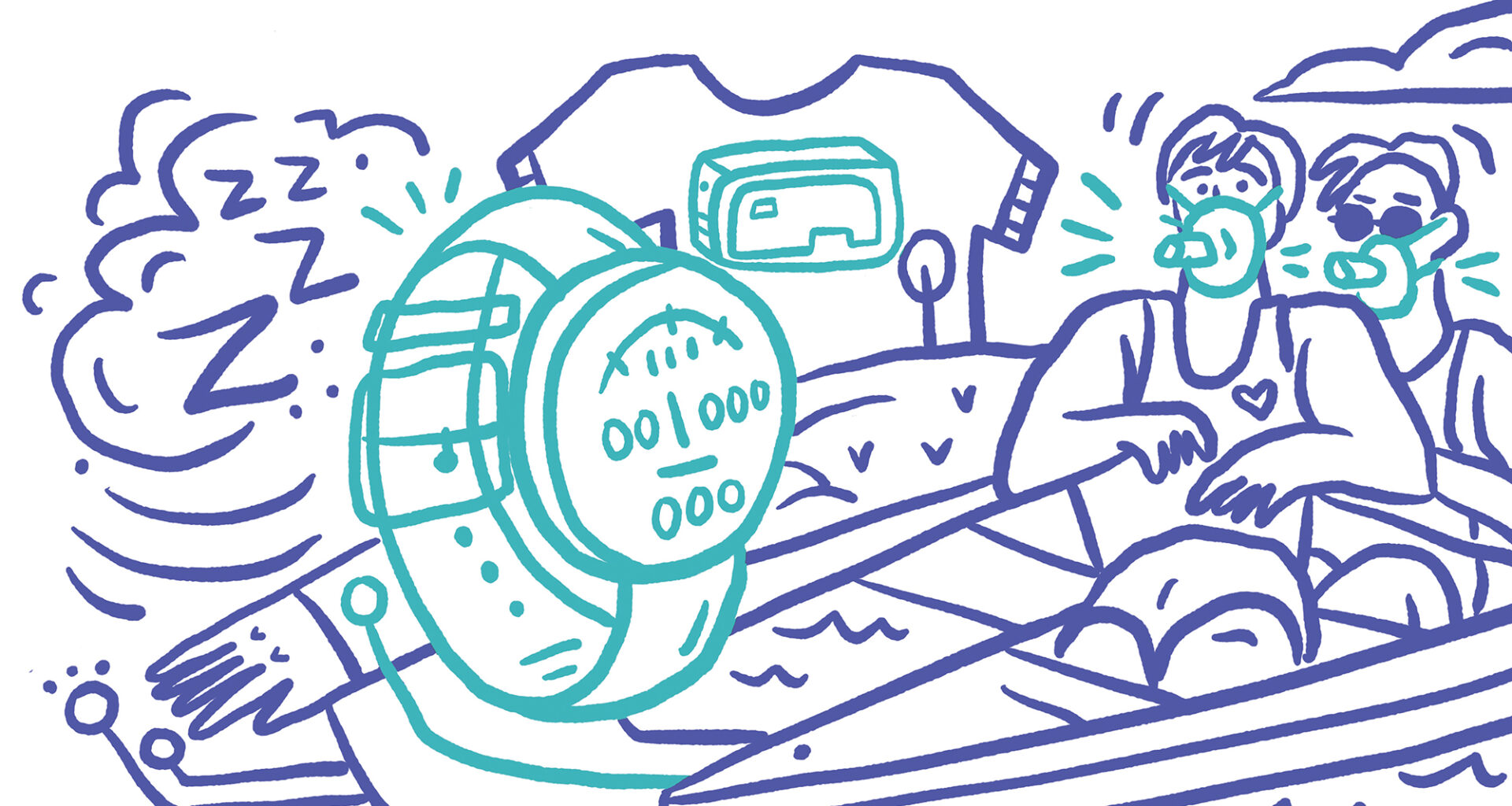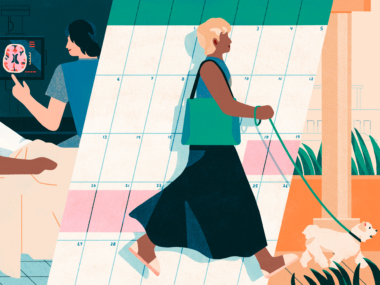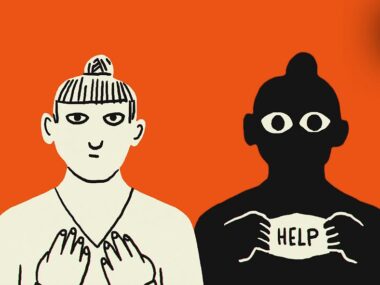Written by Brennan Black, BA’18, and Jaelyn Molyneux, BA’05
Illustrations by Katie Lukes
Of all the changes to the world that circa-1985 Marty McFly encounters in the year 2015 (where he arrives to — what else? — save the future), fantastical wearable technology is among the most inventive. While Back to the Future II’s auto-adjusting jacket and self-lacing Nikes haven’t hit the mainstream yet, they certainly predicted the direction of 21st-century innovation.
Also known simply as “wearables,” current iterations of these devices can be worn as accessories, embedded in clothing, tattooed on the skin or even embedded in the user’s body.
In 2019, the global wearables market, one of the world’s fastest-growing industries, was valued at US$36 billion, and is projected to expand annually at a rate of 15 per cent between now and 2027.
Wearable tech isn’t exactly new (clocks small enough to be worn have been around since 1500), but the growth of mobile networks, high-speed data transfer and miniaturized microprocessors have allowed modern, network-connected wearables to explode onto the scene in recent years.
The most common of these wearables are fitness trackers, including Fitbit and smartwatches, but those are only at the tip of the iceberg. In the medical field, wearable ECG, blood pressure and glucose monitors can help doctors track the health of their patients. Body cams have increased accountability in law enforcement, and virtual reality gear, such as the Oculus Rift, has allowed gamers an even more immersive experience.
Some of the industry’s most cutting-edge research and application innovation, informing and improving our physical and mental health, is being done at the University of Calgary.
The Wearable Technology Research and Collaboration (We-TRAC) program is a partnership between the university and the City of Calgary in which “citizen-scientists” provide their wearable data for analysis by researchers, including founding lead Dr. Reed Ferber, BPE’93, PhD. In combination with 35 other researchers, Ferber has gathered physical activity data that’s being used to improve the experience of walking and cycling on the city’s roads and pathways.
Dr. Teddy Seyed, BSc’11, MSc’13, PhD’19, leads wearable research and initiatives at Microsoft Research. His work in the field has included collaborating with some of the world’s major fashion houses and, during the pandemic, he collaborated with tech designer Dr. Maggie Orth, PhD, to create face masks for people with disabilities. Seyed and his colleagues at Microsoft Research are developing wearable technology that includes everything from environmentally sensing scarves to mother-daughter dresses that light up when they get near each other.
Meanwhile, Olympic wrestler Erica Wiebe, BKin’12, BA’16, used Hexoskin biometric clothing to track her performance and refine her training.
For now, we’ll continue manually adjusting our jackets and tying our shoes but, wait for it — the future is here.
A Fine Balance
Detecting concussion and triggering reflexes
Springboarding off their research into measuring head trauma in boxers and Muay Thai fighters, Dr. Ryan Peters, PhD, and his team in the Faculty of Kinesiology are creating wearable devices that could help protect those athletes as well as provide therapies for people with neuro-degenerative conditions like multiple sclerosis and Parkinson’s disease.
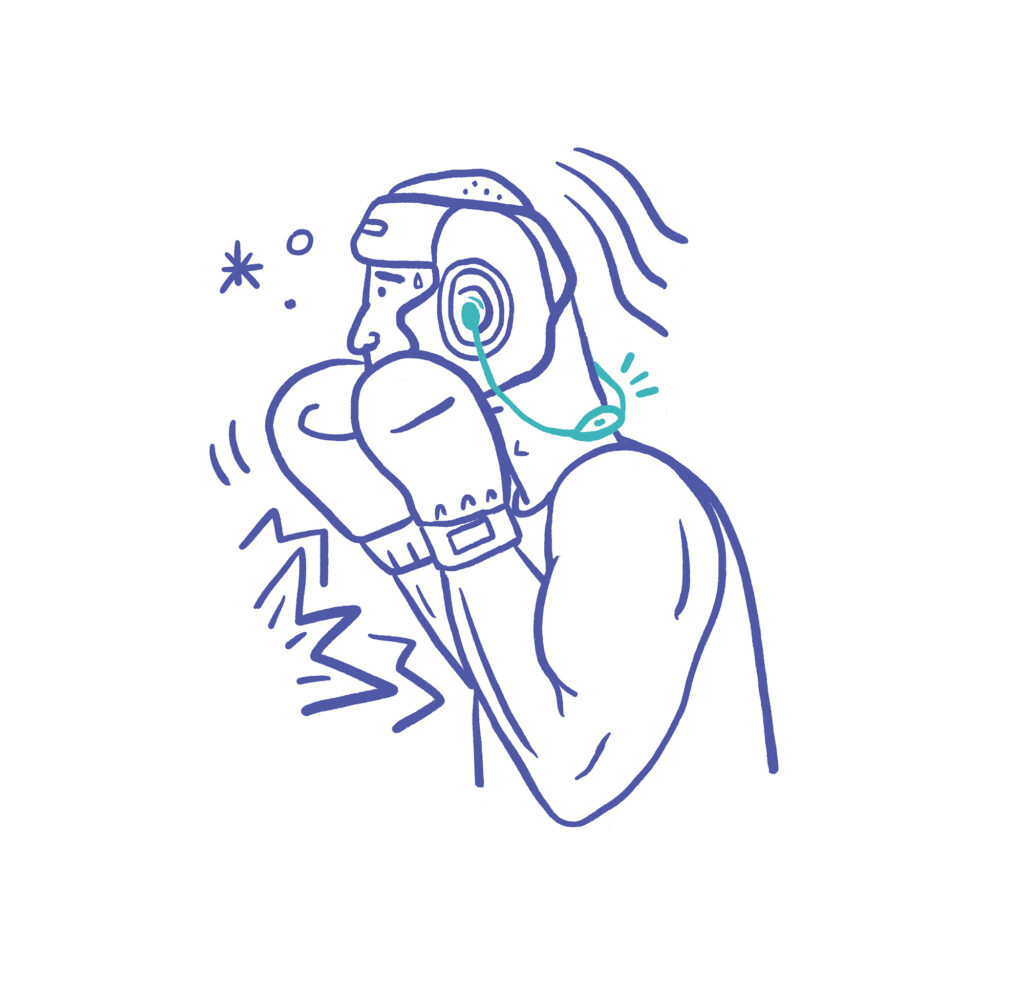
Inside our inner ear is the vestibular system. It includes tiny hair cells that are important for controlling balance, eye stabilization and orientation. Those cells can be damaged by aging, disease and the hits to the head that a boxer might take. To measure that damage, Peters developed a technique called Electrical Vestibular Stimulation (EVS) that applies low-level electrical currents to those hairs, tricking them into thinking the head is moving, and triggering reflexes in the legs to keep the body in balance. He measures the speed and strength of those reflexes to assess the damage.
Peters is collaborating with Silicon Valley’s PROTXX (with operations based in Calgary) to create a wearable EVS system that could make for quick ringside assessments that would give athletes quantitative information to decide if they should go back in the ring.
As well, Peters has a patent pending on a device that goes behind the ear and measures balance. “You can think of it like a neuro-prosthetic system,” he says. Electrical currents that trigger reflexes would set an off-balance wearer right again. The device, is being tested in the lab with various populations, including those with neuro-degenerative conditions.
At Onesie with Technology
Improving language skills for kids
Understanding how well your baby’s language skills are developing, and what you can do to help, gets easier when you drop a recorder into their onesie. LENA (Language ENvironment Analysis) is a small, wearable device that collects audio files of babies and their caregivers. It runs the files through an algorithm that generates a report with biometric data that measures the baby’s language environment, including adult words, baby’s words, conversational turns and background noise. That information can be used by caregivers to help them improve the conversations they have with their babies.
“We know that the gold in infant language-acquisition is conversational turns,” says Dr. Penny Pexman, PhD, who leads the Language Processing Laboratory in the Department of Psychology. “It’s those kind of reciprocal interactions with a caregiver where kids learn a ton of language skills.”
Calgary Reads uses a LENA program, based out of the U.S., that includes 10 weeks of workshops, videos and tips along with the recording technology for families. The program is successful, but the technology component is expensive and Calgary Reads wants to know how much of the success is down to the technology and how much is because of the workshops. LENA has never done a technology-only control group to determine that.
That’s where Pexman and her team come in. They’re giving families a onesie with the recorder to use without the programming. The data collected over those 10 weeks will be compared to participants who also attended workshops. The results will help determine if the wearable tech is the key to improved language skills, or if success comes down to the other tools.
Hunt, Gather, Breathe
Fighting modern disease
Dr. Vivek Venkataraman, PhD, an assistant professor in the Department of Anthropology and Archaeology, is an evolutionary anthropologist interested in studying how much energy it takes to complete activities that were common hundreds of thousands of years ago (i.e., climbing trees, digging, hunting and gathering, and rowing). To do that, he provides respirometry masks to workers in remote fields in Malaysia who wear the masks while they go about their daily tasks. The mask measures the oxygen consumption and carbon dioxide emissions in each breath. That, in turn, provides data on how much energy an activity takes.

Energy expenditure is linked to “diseases of civilization” like obesity and diabetes, as well as metabolic syndrome which includes increased blood pressure, abnormal cholesterol, and excess fat around the waist — all of which lead to higher risk for stroke and heart disease. These are modern health issues that rapidly expanded with industrialization. Since we can’t rewind time to understand what happened to our bodies through that massive shift in society, Venkataraman studies remote communities who are just now going through that transition.
“We work with Indigenous groups that are undergoing subsistence transition,” says Venkataraman. “A lot of them are born in the rainforest. They grew up hunting and gathering, but their lives are changing very rapidly. It’s valuable to understand the causality behind changes to human metabolism that come with capitalism, market integration and globalization.”
A deeper understanding of the data behind how the human body changes with changes to environment, diet and physical activity could have implications for policy and health care.
Do Not Disturb
Post-stroke assessment for improved treatment
While a stroke happens in arguably the most complex area of our body — the brain — a cornerstone of evaluating and monitoring stroke patients comes down to watching their body movement.
A stroke occurs when blood supply to the brain is impeded or reduced. If one has a stroke in the left side of the brain, there can be weakness in the right side of their body, and vice versa. Paying attention to that movement is important for monitoring stroke patients.
“Right now, the only way we can detect an improvement or worsening in strength is a bedside assessment,” says Dr. Mohammed Almekhlafi, MD, a member of the Hotchkiss Brain Institute at the Cumming School of Medicine. “In severe cases, those assessments might need to be done every 15 minutes, including through the night.”
Those hands-on assessments are disruptive and that can also lead to imprecise results. For example, if a patient is woken up to be assessed, it can be difficult to know if their movement is weaker because they are sleepy or if it is related to stroke worsening or even a new stroke. To improve on that, Almekhlafi is studying the use of sensors. He’s currently working with camera technology that detects and registers when a patient moves. Anyone who has played a video game with an avatar that mirrors how you lift your arm or take a step has used similar technology. In the case of stroke patients, a camera is set up in their hospital room to track movement. The data is used to better understand the patient’s progress and inform treatment options, all without continually disturbing them.
Almekhlafi’s study is in the proof-of-concept phase to determine how much and what data the sensors should collect. After that, it will incorporate wearable technology that will continue to make data collection less disruptive and subjective.
Sleepless in Finland
Tech to improve your rest
So, your watch tracks your sleep — but how does that tracking stack up against proven science? Dr. Marc Poulin, PhD, DPhil, a professor in the Cumming School of Medicine and Faculty of Kinesiology, and his team put one watch to the test.
The gold standard for measuring sleep is called polysomnography. It involves devices that measure breathing, heart rate and oxygen saturation, as well as electrodes on the head to measure brainwaves. Typically done in sleep labs, polysomnography can now be done in people’s homes, thanks to technology developed by Poulin at UCalgary.
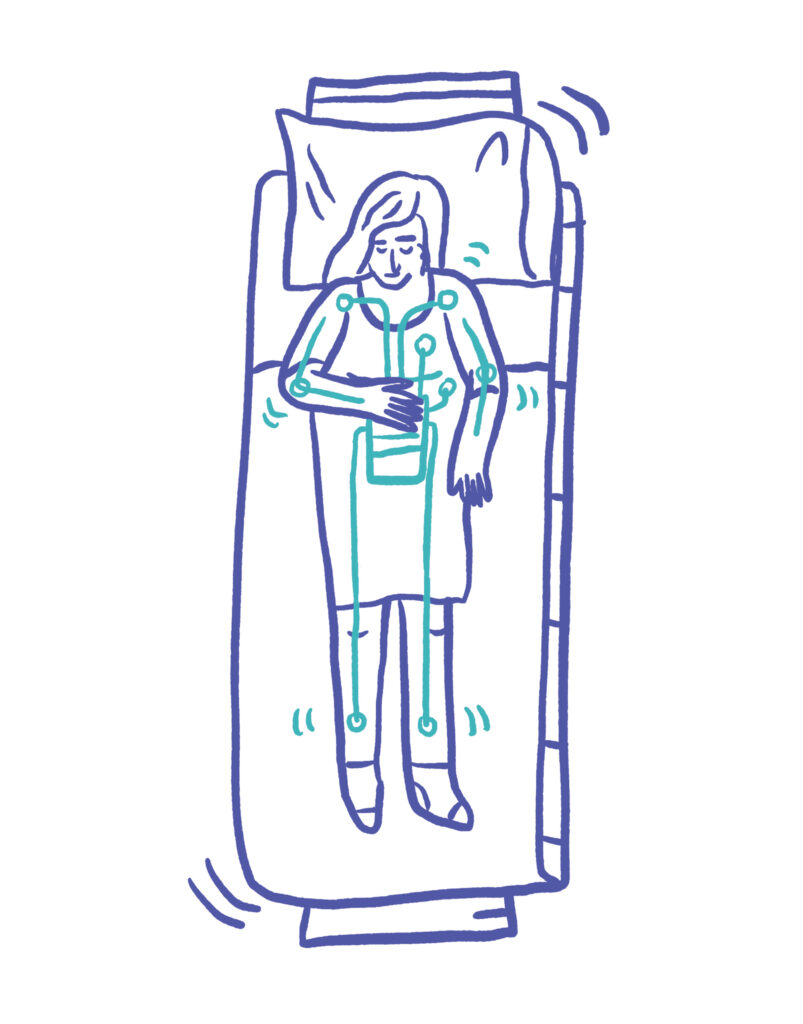
When Finnish company Polar Electro Oy developed its new heart rate-based Sleep Plus Stages algorithm for its smartwatch, it wanted to validate its data by comparing it to the gold standard that Poulin had honed. Poulin and his team tested 36 healthy adults wearing Polar’s smartwatch over two nights of sleep (one after rest and one after exercise). They were measuring for accuracy, specificity and sensitivity. While it didn’t match the much more intensive polysomnography testing, it did outperform other similar technology on the market for the detection of sleep stages.
Polar is particularly interested in using this technology for elite athletes to help them optimize training and sleep. With more investigation and refinement, the watch could also make sleep data more robust and accessible for anyone experiencing daytime fatigue, issues concentrating or other general health concerns related to sleep.
“Sleep is a very exciting new area of research and physiology,” says Poulin. “There’s a lot we still don’t understand about it, and increasingly the technology to measure sleep is improving.”
We Are What We Wear
Can clothing make you feel better?
What would happen if computers managed our emotions for us? Kathryn Blair, MFA’18, a doctoral student in the Computational Media Design program in the University of Calgary’s Department of Computer Science, explores that provocative question via haute couture.
Blair’s conceptual fashion has embedded sensors that track the wearer’s heart rate, temperature and how well their skin conducts electricity. All of those are indicators of current emotions. In other projects, Blair also incorporated an electroencephalogram (EEG) into one of her fashion pieces that detects the electrical activity in the wearer’s brain.
While most commercial wearable tech uses mood-trackers for awareness — like your smartwatch that suggests maybe you should meditate or take a deep breath when your pulse increases — Blair’s tech-meets-art takes it a step further. The data collected by her clothing triggers a small computer to manage and manipulate the wearer’s mood by changing colour or playing a song.
The technology Blair uses is widely accessible, and she’s interested in exploring just how much control we want to give it.
“Our minds and our bodies are inherently related to each other,” says Blair. “Our emotions do come through in our physiological indicators, but how much do we want the responses to be automated? I would love to not have to do the emotional labour to make myself feel better or manage my emotions. It would be lovely to have a computer system do that for me — but I’m also terrified of that idea.”
